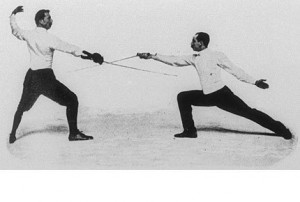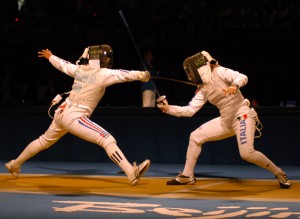A resounding victory scored Cuban fencing team in 1922 when, in an international competition held in the Atletic Club of New York, our national team, which contested the three weapons, foil, epee and saber-beat throughout to the American fencers line.
They were part of the Cuban delegation Ramon Fonts, Silvio de Cardenas, David Aizcorbe and Hector Eduardo Alonso, among others, and as captain was Manuel Dionisio Díaz, impressive technical athlete. Much of the success corresponded to maestro José María Rivas, who has worked hard in training our countrymen. The preparation of the team was held in the armory Dependent Association of Commerce of Havana, located in the social structure of Prado and Trocadero, which lies some years the National School of Dance. It was in the same place, in the same year of 1922, where, in the heat of Pius master Alonso, was founded Cuba Fencing Federation.
It dind’t finish our thriumph in the Atletic Club with the Cuban wins. Were repeated in Washington and Boston and in the same city again prevail in the meetings held at Harvard University. Such a string of victories had an immediate result: made to overflow the excitement in the halls of weapons that existed on the island
CROSSING OF TEACHERS
Then something interesting happened. Such was the international fame of Fonts that many teachers of fencing in every Cuban thought was an ace of spade in power. That was positive as naive as it may seem. For outstanding fencers from other countries settled in Havana, which became a real crossing masters and champions. They charge exorbitant fees for their lessons. Up to the Earl of St. Malate Athos, author of one of the codes governing duels, was here.
Then multiplied arms rooms. Eduardo Alesson, arrived from Spain, he opened his own theater in Payret mezzanines. And Jules Loustalot, another in Monserrate between Pavement and Tejadillo. Pius Alonso consolidated Dependent Center. The Cuban Desiderio Ferreira, who in the 40 die shot at the door of his home in the peaceful San Miguel-sharing account pass for his past Machado-installed his room on the premises which was the Union Club in Zulueta and Neptune, a place to which he gave a red tone that made him attractive and original.
There were also weapons rooms at the Miramar Yacht Club and the College of Architects. At the headquarters of the Red Cross, at the Institute and at the University of Havana. The was also in the Army and Navy. Politicians who at one point were trained and practiced preferably Loustalot, had the weapons room of the Capitol, one of the most beautiful in the city, by the already mentioned José María Rivas. The journalists had his headquarters Reporters Association.
Not all those who came to fencing practices did so love the sport or for the honor of representing colors someday country. Still in the 40s of last century was enough to make anyone feel offended to raise the so-called question of honor. Then appointed their representatives, who visited the offender, and this in turn appointed his own. The sponsors of both sides met to agree on the conditions of the haul: date and place of the meeting, the weapon that dirimiría the matter and how the confrontation transpire.
The weapon of choice could be the sword or the French sword, saber tipped or not, or sharp, contrafilo and tip … Once established gun determined how many reprisses godparents would be the combat, which lasted each and the rest time between them. If selected the gun, the gun was strictly prohibited, how many shots would be fixed the contestants and how many steps and if you shoot at will or a voice command. The going got tough when he remembered that the match out with all the consequences or any game, as they said, but still the duelists should obey the judge’s orders and abide field without question their determination to end the set.
JOURNALISTS AND POLITICIANS
Journalists and politicians were among the most challenged to a duel and were among the most were fighting. Among the first, on our own, Wilfredo Fernandez fought five times, Santiago Claret, eight, Muzaurrieta, nine and Antonio Iraizoz, 16. There is no evidence that Grau San Martin has never beaten, although it reached duel challenge Bohemia director for information that appeared in “In Cuba”. Famous was the duel of Ricardo Núñez Portuondo, liberal politician and physician to the tyrant Machado, that struck his rival, morbid curiosity to 200 spectators, a wound of that chopped 15 inches from the forehead to the chest.
Master Rivas specialized in affairs of honor and were many in which participated as field judge. It can be said that there was no outstanding politician not to use their services. These Eduardo Kids, who fought nine times with figures such as Tony Varona, Inocente Alvarez and Francisco Alberto and Carlos Prio. On the occasion of Chibás duel with Senator José Manuel Casanova, Tsar Sugar, Rivas said the first was not enough courage, but it required a little technical. It should, he argued, visual tracking gun tip opponent.
-Look, Rivas, that is the opposite concern because I see neither the tip of mine said that she had Chibás barbaric myopia was hurt almost all of his duels.
Sources:CiroBianchiRoss/Excerpts/InternetPhotos/www.thecubanhistory.com
FIGHTING WITH SWORDS (Fencing), sensational art in Cuba. History
The Cuban History, Arnoldo Varona, Editor
LA ESGRIMA en la Republica: un arte convertido en sensación.
Un triunfo resonante se anotó la esgrima cubana en 1922, cuando, en una competencia internacional que tuvo lugar en el Atletic Club de Nueva York, el equipo del patio, que contendió en las tres armas –florete, espada y sable- derrotó en toda la línea a los esgrimistas norteamericanos.
Formaban parte de la delegación cubana Ramón Fonts, Silvio de Cárdenas, David Aizcorbe y Eduardo Héctor Alonso, entre otros y como capitán iba Manuel Dionisio Díaz, deportista de técnica impresionante. Buena parte del éxito correspondió al maestro José María Rivas, que trabajó con tesón en el entrenamiento de nuestros compatriotas. La preparación del equipo se llevó a cabo en la sala de armas de la Asociación de Dependientes del Comercio de La Habana, ubicada en su edificio social de Prado y Trocadero, donde radica desde hace unos años la Escuela Nacional de Danza. Fue en ese mismo lugar, en el propio año de 1922, donde, al calor del maestro Pío Alonso, se fundó la Federación de Esgrima de Cuba.
No finalizaron en el Atletic Club los triunfos cubanos. Se repitieron en Washington y en Boston y, en esa misma ciudad, volvieron a imponerse en los encuentros que sostuvieron en la Universidad de Harvard. Tal cadena de victorias tuvo un resultado inmediato: hizo que se desbordara el entusiasmo en las salas de armas que existían en la Isla.
CRUCE DE MAESTROS
Sucedió entonces algo interesante. Tal era la fama internacional de Fonts que muchos maestros de la esgrima pensaron que en cada cubano había un as de la espada en potencia. Eso resultó positivo por ingenuo que pueda parecer. Porque destacados esgrimistas de otros países se instalaron en La Habana, que se convirtió en un verdadero cruce de maestros y campeones. Cobraban sumas exorbitantes por sus lecciones. Hasta el conde Athos de San Malato, autor de uno de los códigos que regían los duelos, estuvo por aquí.
Se multiplicaron entonces las salas de armas. Eduardo Alesson, llegado de España, abrió la suya en los entresuelos del teatro Payret. Y Jules Loustalot, otra en Monserrate entre Empedrado y Tejadillo. Pío Alonso se consolidó en el Centro de Dependientes. El cubano Desiderio Ferreira, que en los años 40 moriría baleado ante la puerta de su casa en el apacible reparto San Miguel –un pase cuenta por su pasado machadista- instaló su sala en el local que fue del Unión Club, en Zulueta y Neptuno, un espacio al que dio un tono rojo, que lo hacía atractivo y original.
Hubo asimismo salas de armas en el Miramar Yacht Club y en el Colegio de Arquitectos. En la sede de la Cruz Roja, en el Instituto y en la Universidad de La Habana. Las hubo también en el Ejército y en la Marina de Guerra. Los políticos que en un momento se entrenaron y practicaron preferiblemente con Loustalot, contaron con la sala de armas del Capitolio, una de las más bellas de la ciudad, a cargo del ya aludido José María Rivas. Los periodistas dispusieron de la suya en la sede de la Asociación de Reporters.
No todos los que acudían a las prácticas de esgrima lo hacían por amor al deporte o por el honor de poder representar algún día los colores del país. Todavía en los años 40 del siglo pasado bastaba con que alguien se sintiera ofendido para que planteara la llamada cuestión de honor. Designaba entonces a sus representantes, que visitaban al ofensor, y este a su vez designaba los suyos. Los padrinos de una y otra parte se reunían para pactar las condiciones del lance: lugar y fecha del encuentro, el arma con que se dirimiría el asunto y la forma en que transcurriría el enfrentamiento.
El arma escogida podía ser la espada o la espada francesa, el sable con punta o sin ella, o con filo, contrafilo y punta… Una vez decidida el arma establecían los padrinos a cuántas reprisses sería el combate, lo que duraría cada una de ellas y el tiempo de descanso entre una y otra. Si seleccionaban la pistola -el revólver estaba terminantemente prohibido- se fijaba cuántos disparos harían los contendientes y a cuántos pasos y si dispararían a discreción o a una voz de mando. La cosa se ponía fea cuando se acordaba que el duelo fuera con todas las consecuencias o a todo juego, como se decía, pero aun así los duelistas debían obedecer las órdenes del juez de campo y acatar sin chistar su determinación de dar por finalizado el lance.
PERIODISTAS Y POLÍTICOS
Periodistas y políticos eran de los más retados a duelo y figuraban entre los que más se batían. Entre los primeros, por nuestra cuenta, Wifredo Fernández se batió cinco veces, Santiago Claret, ocho, Muzaurrieta, nueve y Antonio Iraizoz, 16. No existe constancia de que Grau San Martín se haya batido nunca, aunque sí llegó a retar a duelo al director de Bohemia por una información que apareció en la sección “En Cuba”. Famoso fue el duelo de Ricardo Núñez Portuondo, político liberal y médico de cabecera del tirano Machado, en que propinó a su rival, ante la curiosidad morbosa de 200 espectadores, una herida de 15 centímetros que lo tajó desde la frente hasta el pecho.
El maestro Rivas se especializó en los lances de honor y fueron muchos en los que intervino como juez de campo. Puede decirse que no hubo político sobresaliente que no utilizara sus servicios. Entre ellos Eduardo Chibás, que se batió nueve veces con figuras tales como Tony Varona, Alberto Inocente Álvarez y Francisco y Carlos Prío Socarrás. En ocasión del duelo de Chibás con el senador José Manuel Casanova, el Zar del Azúcar, advirtió Rivas al primero que no bastaba el coraje, sino que se requería de un poco de técnica. Es preciso, arguyó, seguir con la vista la punta del arma del rival.
-Mire, Rivas, esa será la preocupación del contrario porque yo no veo ni la punta de la mía –respondió Chibás que padecía de una miopía bárbara y salió herido de casi todos sus duelos.
Sources:CiroBianchiRoss/Excerpts/InternetPhotos/www.thecubanhistory.com
FIGHTING WITH SWORDS (Fencing), sensational art in Cuba. History
The Cuban History, Arnoldo Varona, Editor



 FIGHTING WITH SWORDS (Fencing), sensational art in Cuba. History * LA ESGRIMA en la Republica: un arte convertido en sensación. Historia.
FIGHTING WITH SWORDS (Fencing), sensational art in Cuba. History * LA ESGRIMA en la Republica: un arte convertido en sensación. Historia.


